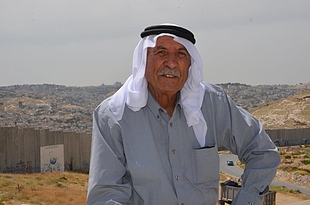New interactive map highlights the hardship of families affected by the Barrier
“Today we find ourselves surrounded by a wall”
This year marked the tenth anniversary of the 2004 International Court of Justice (ICJ) Advisory Opinion on the Legal Consequences of the Construction of a Wall in the Occupied Palestinian Territory. Throughout the year, OCHA OPT has been active in drawing attention to the ongoing impact of the Barrier by focusing on the stories of those affected. In East Jerusalem, OCHA OPT is using an interactive map to tell the story of families from one part of the city who have been physically divided since the Barrier construction.
“I have been a resident of this area for more than 60 years,” says Sami As Surkhi, a retired school principal. “We had hoped that the situation would improve, but today we find ourselves surrounded by a wall.”
 Sami remembers when he and his family used to gather at his home in As Sawahireh Al Sharqiya to celebrate holidays and weddings. The Barrier has largely put an end to that. The family house is located within the Israeli-defined municipal area of Jerusalem, but is now cut off from the remainder of East Jerusalem by the Barrier, leaving it on the West Bank side.
Sami remembers when he and his family used to gather at his home in As Sawahireh Al Sharqiya to celebrate holidays and weddings. The Barrier has largely put an end to that. The family house is located within the Israeli-defined municipal area of Jerusalem, but is now cut off from the remainder of East Jerusalem by the Barrier, leaving it on the West Bank side.
“Do you see that tree on the other side of the wall, right next to it? That’s my daughter’s house. We don’t see each other very often anymore since the wall was built.” What used to be a five-minute walk (600 metres) to her house is now an arduous and costly trip through checkpoints.
Israel began construction of the Barrier in Abu Dis, Al ‘Eizariya and As Sawahireh Al Sharqiya area in 2002 following a series of deadly attacks against Israeli civilians. By 2005, the area, which used to be one of East Jerusalem’s thriving business hubs, was cut off completely from its historical centre, affecting the lives and income of thousands of residents.
In its Advisory Opinion, the ICJ recognized that Israel ‘has to face numerous indiscriminate and deadly acts of violence against its civilian population’ and that it ‘has the right, and indeed the duty, to respond in order to protect the life of its citizens. [However], the measures taken are bound nonetheless to remain in conformity with applicable international law.
The ICJ stated that the sections of the Barrier route in the occupied Palestinian territory, including East Jerusalem, violated Israel’s obligations under international law. The ICJ called on Israel to cease construction of the Barrier ‘including in and around East Jerusalem’; dismantle the sections already completed; and ‘repeal or render ineffective forthwith all legislative and regulatory acts relating thereto’.









